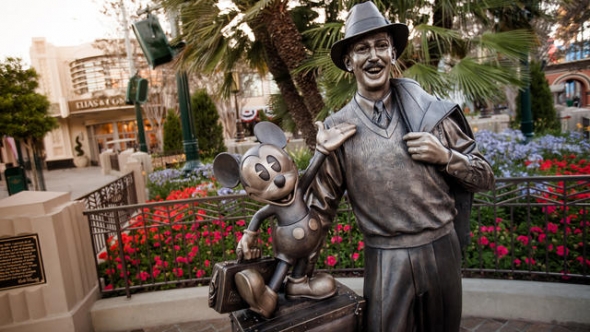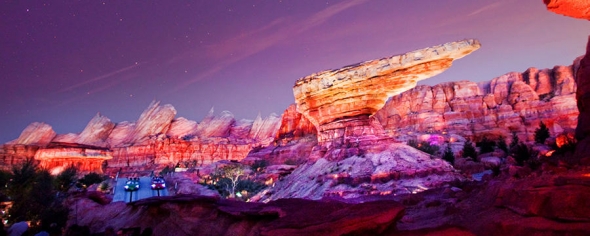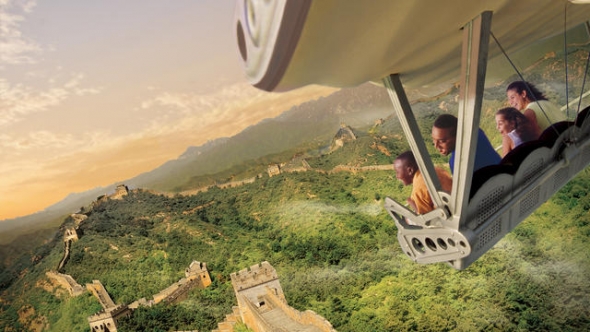
The construction of Disney theme parks rarely goes smoothly. The recent behind-the-scenes rumors and facts about Shanghai Disneyland reinforce this fact. Since the opening of the original Disneyland in 1955, life has gotten in the way of the best laid plans of Imagineers. Whether it was a mob of fake ticket holders cheating their way into the Happiest Place on Earth or the death of a visionary causing tumult and indecision, even the most storied Disney gates suffer through their share of construction struggles.
The same is true of Disney park expansions. Disney’s Hollywood Studios and Disney’s Animal Kingdom are two of the eight most trafficked theme parks in the world, yet they’ve struggled in the face of public criticism throughout their existences. One of the problems Disney faces as the worldwide leader in theme park entertainment is unreasonable expectations. The company has raised the bar in their industry so many times over the past 60+ years that consumers expect it of them. Disney isn’t merely battling the other companies in the vacation oligopoly. They’re also fighting against their own track record.
At times, this task proves overwhelming. Guests are at their most critical the first time they enter a new park, see a themed land for the first time, or enjoy an attraction they’ve never ridden before. Anything that has the Disney stamp on it comes with lofty public expectations. So what happens when a Disney expansion is evolutionary rather than revolutionary? Park fanatics quickly proclaim that it lacks magic, that it’s unworthy of the Disney name. Oddly, they still show up anyway, which is a testament to the loyalty customers feel toward the Disney brand. They complain, though. Boy, do they ever. Fans feel such a connection to Disney’s Parks and Resorts division that they consider themselves a part of it. When something isn’t right, they, the customers, express their opinions loudly.
To the company’s credit, Disney regularly listens. That’s why they constantly upgrade and expand. Walt Disney believed in the concept of plussing, constantly dedicating resources to perfecting what many considered already perfect. It’s also what gets them into trouble. At times, their grand ambitions exceed their ability to bring the big ideas to fruition. Even Disney park planners fall victim to that odd part of human nature that entitles us to dream big but never quite achieve our true goals. Something wonderful in theory can fail in execution, sometimes through no fault of its own.
Image: Disney
A perfect demonstration of this scenario occurred at Disneyland roughly four decades after its launch. Disney execs finally committed to expanding to their smallest theme park. They acquired new land and renovated a parking lot, all the while plotting unprecedented attractions, a few of which even went directly against the wishes of the company’s founder. By this point, Disney park planners had grown so confident in their abilities that they felt they understood Uncle Walt’s legacy enough to ignore his stipulations, at least the ones they considered outdated.
You know the expansion as Disney California Adventure. You also know that its traffic has increased dramatically in recent years. In this article, I’ll chronicle what Disney needed from the second gate at Disneyland and how they got it despite absorbing a beating in the early days. I’ll also show why some of its struggles grew overstated due to national news that tragically affected most industries. And I’ll discuss how it overcame those flaws, evolving into a lauded theme park full of the type of theming that would make Uncle Walt proud. I’m of the opinion that Disney California Adventure gets a bad rap, and if you read along, I’ll try to show you why.
Why visit real mountains when you can see artificial ones at Disney?
Even though I’ve already stated that I think Disney California Adventure gets a bad rap, I can’t defend much of what Eisner did here. A noted egomaniac, one of his primary goals was to leave an imprint on Disney history. He wanted his name linked forever with that of Walt Disney, the founder of the company. As you well know, fate had other plans.
Eisner’s tenure ended with a whimper rather than a bang. During a fated 2004 shareholders’ meeting, almost half of stock owners at the company refused to extend his contract. By this point, he’d lost the faith of many Disney loyalists. They frequently mentioned Disney California Adventure as one of his failed endeavors. Nearly a decade after his decision to make a mark on Disney history, Eisner found himself hoisted by his own petard.
What went wrong? A cynic might say everything. I find such responses glib. Disney’s staff of devoted employees has stood as the finest in the world for generations now. They didn’t suddenly take leave of their senses during the planning phase of what was then known as Disney’s California Adventure. Instead, they worked diligently to make magic out of the concepts authorized by their superiors. What I’m saying here is that it’s all Michael Eisner’s fault.
Image: Disney
During the genesis of Disney's California Adventure, the doomed CEO and his trusted lieutenants engaged in a brainstorming session. They established a checklist of items they wanted to accomplish with a Disneyland expansion. One of oddest aspects of this list was the inclusion of California itself. The company’s power players lamented the fact that Disney didn’t dominate the state tourism market to the degree they desired. In Eisner’s estimation, Disney should own California as a kind of paid tribute to Uncle Walt. He sought to increase the value of the world’s original theme park by adding elements from other popular California landmarks. In the process, the second gate at Disneyland would restore the balance on the company balance sheet, siphoning business away from local competitors.
Who were the enemies who threatened Eisner’s beloved balance sheet? No, I don’t mean Universal Studios Hollywood or even Knott’s Berry Farm. Disney never viewed other theme parks as viable threats to its bottom line. The competitors who caused Eisner to see shadows included Yosemite National Park, Sequoia National Park, Joshua Tree National Park, Newport Beach, and Napa Valley wine country.
As crazy as this sounds, Eisner resented that theme park tourists might choose to get in touch with nature rather than spend every waking moment at Disneyland. This unusual thought process is the underlying mechanism that explains why Eisner led Disney down a bad path. Rather than conceiving of original theming concepts that would attract guests to Disney, Eisner tasked his inner circle with an unusual goal. Their job requirement became luring tourists away from national parks. He didn’t want potential customers becoming at one with nature. Eisner’s behavior is not that far removed from supervillainy, really.




Comments
You said...
"We expect the most out of Disney, and we consider it our duty to protect the brand even though we’re technically unaffiliated with it. "
And I personally think this is in error, we are very much affiliated with the parks and the brand. We may not be stock holders (actually I am) but we are stakeholders. Our money is what keeps the parks going and since we visit and spend our money voluntarily we have the right to demand the best from the parks and company.
Currently (mid 2017) Disneyland is packing in the cheap customers to shoulder to shoulder levels and this along with all of the construction is hurting the park and it's image with tourists..
I first visited California Adventure during a pre-opening preview. Although I was excited to get a chance to see the park before the general public, it was obvious from the start that it was somewhat confused. Between Mondavi wines and carnival style vomit rides, it was hard to understand who the customer was supposed to be. Of course, the whole thing has improved dramatically since then, but I think it's telling that I visited once in early 2001, then didn't come again until 2015.
To my thinking, Disney has opened three sub-par parks: California Adventure, Disneyland Hong Kong, and Disney Studio Paris. Today, California Adventure is a terrific park and getting better. The Hong Kong park was expanded and is now a very nice "small" Disney park with two world class attractions: Mystic Manor and Grizzly Run. Iron Man is coming. The only Disney park I would still rank sub-par is Disney Studio Paris. They need a few more Remy's Great Escape to bring the park up to what is should be.
Great article and nice argument. I agree Eisner expanded the Disneyland brand into a resort, but I disagree that once "Disney's California Adventure [was] up and running, they could follow the Disney mandate of “plussing” their way to a better tomorrow." Michael Eisner lost his job and legacy over his “taking the hit by adding cheap, un-Disney attractions.”
The strategy worked for Eisner in Walt Disney World with Hollywood Studios, Animal Kingdom, Downtown Disney, hotels and Disney Vacation Club – but it decidedly failed in Anaheim and Paris. Walt Disney Studios was built on the cheap to expand the Disneyland Paris Resort, but one could argue the whole resort remains a failure, despite trying to duplicate the same game plan: add a second gate (on the cheap for a foundation) and invest later. The “plussing” of Tower of Terror, Ratatouille, and other investments (or lack of maintenance over the years) has decidedly made the Disneyland Paris brand weaker, not stronger, and is still a topic of debate.
I’m not sure Michael Eisner would have had the strength of courage to make the investments of Bob Iger: purchase Pixar, Marvel, Star Wars and invest $1.1 billion in California Adventure, $5.5 billion in Shanghai. Learning from Disneyland Tokyo Resort – I think it’s a better argument a second gate should not be built unless up to Disney standards.
Eisner could very well have expanded the Disneyland “resort” with Downtown Disney, new hotels, and new lands at Disneyland… people would have still come. Universal Studios in Hollywood seems to be doing just fine with the expansion of Simpsons, Minions, Harry Potter and CityWalk upgrades, without the need for a second gate. Likewise, Hong Kong Disneyland is building a third hotel and is clearly expanding into a “resort” without a second gate but with expanded options for overnight guests.
We did not need the cheap version of California Adventure to increase the Disneyland brand. If anything, the Disney and Disneyland brand were both hurt (as reflected in a stagnant stock price for years) by a cheap theme park, and was only saved with an unprecedented level of investment. It wasn't just "plussing" the park, the entire front section of the park gutted, rebuilt and rethemed, and other lands are being reinvented. Now if only they could rebuild Walt Disney Studios (like Hollywood Studios).
But back to the Disneyland Resort, with Star Wars Land and the new high-end hotel confirmed, and rumors of more Marvel and Frozen attractions, we can agree the Disneyland brand looks bright.